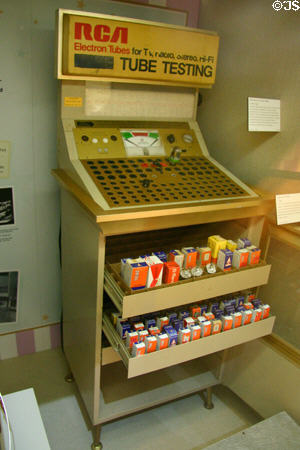 μTracer
μTracer
I have a fascination with vacuum tubes – “valves”. So, I needed a way to test tubes. Gone are the mammoth corner drug store tube testers. I remember pulling tubes out of the hi-fi, or T.V. and hauling them to the corner drug store and testing them on a machine like this one to the left. No more…
The net to the rescue. Interestingly enough, there is still a strong culture of tube enthusiasts designing, building, selling, and refurbishing tube gear, mostly audio. There’s are also several companies producing tube based modular synthesizer modules.
There are a few options for testing tubes.
- Send your tubes to a business that offers a service to test your tubes. Not a bad way to go, but time consuming and maybe a bit expensive if you have a bunch of tubes.
- Go to ebay and buy an old tube tester. Like all old gear, it may be safe if you know what you are doing. If you don’t know, don’t buy. There are many available, but be careful.
- Buy an old tube tester that has been refurbished by someone that knows what they are doing. There are a few web stores that offer these testers from time to time. Some are more desirable than others, so do some research. I bought an old EICO 667 from the Radiola Guy, and am very happy with it. As a bonus, it also tests transistors.
- Buy a new tube tester. There are a few, but not too many choices. They are mostly geared for the more commonly used audio tubes in new gear. If you’re trying to refurbish some old gear or building from old schematics, you might not be able to test the tubes you need to. I purchased an Amplitrex AT1000 and it’s an impressive tool (see the links to the left for my page on this very impressive tool). Very well done and useful. It’s expensive, but if you want to get into tube gear, you really need something. It has a comprehensive built in tube database to start, and you can add tubes so long as you can get the tube data sheet. This online tube database is gigantic. There are other resources out there, too. Do a web search on vacuum tubes and you will get a lot of hits.
- Last, and the point of this page, DIY! Hey, if your designing and building tube stuff, you probably know enough to either design your own tester, build one from some old schematics, or buy and build a kit. Ronald Dekker’s µTracer is a great example.
µTracer:
This page highlights my implementation of Ronald’s µTracer. This is a very cool device. You can test pretty much any kind of tube, so long as you know how the tube works and you have specifications. You can hardwire sockets for your favorite tubes. You can populate your panel with any kind of tube socket you like. You can do it with independent, separate adapters so you can just add a new tube type as needed. Or, a little of all three. Ronald’s site has a testimonial page which shows many different implementations of his design. Ronald’s site is here. He has a lot of very fascinating information and some other fun projects, too. He has a great page of links to tube sites and some interesting information. I highly encourage you to explore it.
Step 1 – Panel:
I chose to do a panel based on a few common sockets that I use. I also chose to make it a little more intuitive to use an external heater supply and protect with a fuse.
THIS IS A PAGE IN PROGRESS. AS SOON AS I FINISH THE DEVICE, I’LL UPDATE THE PAGE.


